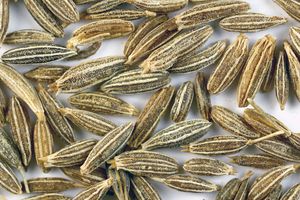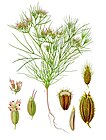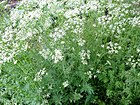Note: This is a project under development. The articles on this wiki are just being initiated and broadly incomplete. You can Help creating new pages.
Difference between revisions of "Cuminum cyminum - Ajaji, Cumin seed"
(→Fruit) |
(→Common names) |
||
| (27 intermediate revisions by 2 users not shown) | |||
| Line 1: | Line 1: | ||
[[File:Sa cumin (1).jpg|thumb|right|''JEERA SEEDS'']] | [[File:Sa cumin (1).jpg|thumb|right|''JEERA SEEDS'']] | ||
| − | + | '''Cuminum cyminum''' is a flowering plant in the family Apiaceae. it is native from the east Mediterranean to South Asia. Its seeds are used in the cuisines of many different cultures in both whole and ground form. It also has many uses as a Traditional medicine plan. | |
| − | '''Cuminum cyminum''' is a flowering plant in the family Apiaceae | ||
==Uses== | ==Uses== | ||
| − | {{Uses|Improving breast milk}}, {{Uses|Uterine fibroid}, {{Uses| | + | {{Uses|Improving breast milk}}, {{Uses|Uterine fibroid}}, {{Uses|Indigestion}}, {{Uses|Diarrhoea}}, {{Uses|Skin diseases}}, {{Uses|Fever}}, {{Uses|Hyper-acidity}}, {{Uses|Insomnia}}, {{Uses|Piles}}, {{Uses|Parasitic worms}}, {{Uses|Leucorrhoea}}, {{Uses|Spider sting}}. |
==Parts Used== | ==Parts Used== | ||
| − | {{Parts Used| | + | {{Parts Used|Seeds}}, {{Parts Used|Fruits}}. |
==Chemical Composition== | ==Chemical Composition== | ||
| Line 12: | Line 11: | ||
==Common names== | ==Common names== | ||
| − | {{Common names|kn=Jirage, | + | {{Common names|kn=Jirage, Bilijirege|ml=Jeerakam|sa=Ajaji|ta=Sheeragam, Chirakam, Jeerakam|te=Jilakarra, Tella Jilakarra|hi=Jira, Safed jira|en=Cumin seed, Cumin}} |
==Habit== | ==Habit== | ||
| − | {{Habit| | + | {{Habit|Shrub}}. |
==Identification== | ==Identification== | ||
===Leaf=== | ===Leaf=== | ||
| − | {{Leaf|Simple| | + | {{Leaf|Simple|Petiole bonded|Hairless, elongated and devided.its foliage is devided into filiform segment}}<ref name="Leaf"/> |
===Flower=== | ===Flower=== | ||
| Line 25: | Line 24: | ||
===Fruit=== | ===Fruit=== | ||
| − | {{Fruit| | + | {{Fruit|Ovel, narrow|5-6mm long|The fruites of the plnat is classified among the nuts and it is daichene|They are ash brown and pubscent|Single seed|}} |
===Other features=== | ===Other features=== | ||
==List of Ayurvedic medicine in which the herb is used== | ==List of Ayurvedic medicine in which the herb is used== | ||
| − | * [[ | + | * [[Bilvādileha]] |
| + | * [[Hingwastak churna]] | ||
| + | * [[Dhatri rasayan]] | ||
| + | * [[Yogaraj guggul]] | ||
| + | <ref name="Ayurvedic preparations"/> | ||
==Where to get the saplings== | ==Where to get the saplings== | ||
| Line 37: | Line 40: | ||
==How to plant/cultivate== | ==How to plant/cultivate== | ||
| − | + | Start seeds inside 6 to 8 weeks before average last frost. Start outside 1 to 2 weeks after average last frost and when the temperatures are warm.<ref name="How to plant/cultivate"/> | |
| − | |||
==Commonly seen growing in areas== | ==Commonly seen growing in areas== | ||
| − | {{Commonly seen| | + | {{Commonly seen|Manitoba}}, {{Commonly seen|Norway}}, {{Commonly seen|Rainyzones}} |
==Photo Gallery== | ==Photo Gallery== | ||
<gallery class="left" caption="" widths="140px" heights="140px"> | <gallery class="left" caption="" widths="140px" heights="140px"> | ||
| − | + | Image:Cuminum_cyminum_-_Köhler–s_Medizinal-Pflanzen-198.jpg | |
| − | + | Image:Historical_CUMIN.jpg | |
| − | File: | + | Cumin plant, Rajasthan (1).png |
| − | + | Cuminum cyminum.jpg | |
| − | + | File:Cuminum cyminum - Köhler–s Medizinal-Pflanzen-198.jpg | |
| − | |||
| − | |||
| − | |||
</gallery> | </gallery> | ||
| Line 58: | Line 57: | ||
<references> | <references> | ||
| − | <ref name="chemical composition">[https://www.bimbima.com/ayurveda/medicinal-uses-of-cuminjeera-seeds/383/ | + | <ref name="chemical composition">[https://www.bimbima.com/ayurveda/medicinal-uses-of-cuminjeera-seeds/383/ Bimbima ayurvedic medicine]</ref> |
| − | + | <ref name="Leaf">[https://www.botanical-online.com/english/cumin_cuminum_cyminun.htm Botanical science]</ref> | |
| + | <ref name="How to plant/cultivate">[http://herbgardening.com/growingcumin.htm Herb gardening]</ref> | ||
| + | <ref name="Ayurvedic preparations">[https://easyayurveda.com/2013/03/13/cumin-seed-benefits-usage-side-effects-ayurveda-details/ Ayurvedic preparations]</ref> | ||
</references> | </references> | ||
==External Links== | ==External Links== | ||
| − | * [ | + | * [https://www.herbal-supplement-resource.com/cumin-uses-medicinal-herb.html Cuminum cyminum on herbal-supplement-resource.com] |
| − | * [ | + | * [http://www.agrifarming.in/cumin-farming/ Cuminum cyminum on agrifarming.in] |
| − | * [ | + | * [http://www.bodyandbeans.com/benefits-of-cumin-seeds-jeera-skin-hair-health/ Cuminum cyminum on bodyandbeans.com] |
| − | * [https:// | + | * [https://changinghabits.com.au/blog/2016/02/09/the-health-benefits-of-cooking-with-cumin/ Cuminum cyminum on changinghabits] |
| − | |||
| − | |||
| − | |||
| − | |||
| − | |||
[[Category:Herbs]] | [[Category:Herbs]] | ||
| + | [[Category:Apiaceae]] | ||
Latest revision as of 16:25, 12 October 2020
Cuminum cyminum is a flowering plant in the family Apiaceae. it is native from the east Mediterranean to South Asia. Its seeds are used in the cuisines of many different cultures in both whole and ground form. It also has many uses as a Traditional medicine plan.
Contents
Uses
Improving breast milk, Uterine fibroid, Indigestion, Diarrhoea, Skin diseases, Fever, Hyper-acidity, Insomnia, Piles, Parasitic worms, Leucorrhoea, Spider sting.
Parts Used
Chemical Composition
Cumin seeds are antimicrobial, anti-diabetic, antiepileptic, antifertility, anticancer, antioxidant and immunomodulatory.[1]
Common names
| Language | Common name |
|---|---|
| Kannada | Jirage, Bilijirege |
| Hindi | Jira, Safed jira |
| Malayalam | Jeerakam |
| Tamil | Sheeragam, Chirakam, Jeerakam |
| Telugu | Jilakarra, Tella Jilakarra |
| Marathi | NA |
| Gujarathi | NA |
| Punjabi | NA |
| Kashmiri | NA |
| Sanskrit | Ajaji |
| English | Cumin seed, Cumin |
Habit
Identification
Leaf
| Kind | Shape | Feature |
|---|---|---|
| Simple | Petiole bonded | Hairless, elongated and devided.its foliage is devided into filiform segment |
Flower
| Type | Size | Color and composition | Stamen | More information |
|---|---|---|---|---|
| Unisexual | White, Pink | The flowers are like tiny hermaphrodite and each umbelmay cotain between 3 or 5 radios. | {{{5}}} |
Fruit
| Type | Size | Mass | Appearance | Seeds | More information |
|---|---|---|---|---|---|
| Ovel, narrow | 5-6mm long | The fruites of the plnat is classified among the nuts and it is daichene | They are ash brown and pubscent | Single seed |
Other features
List of Ayurvedic medicine in which the herb is used
Where to get the saplings
Mode of Propagation
How to plant/cultivate
Start seeds inside 6 to 8 weeks before average last frost. Start outside 1 to 2 weeks after average last frost and when the temperatures are warm.[4]
Commonly seen growing in areas
Photo Gallery
References
External Links
- Ayurvedic Herbs known to be helpful to treat Improving breast milk
- Ayurvedic Herbs known to be helpful to treat Uterine fibroid
- Ayurvedic Herbs known to be helpful to treat Indigestion
- Ayurvedic Herbs known to be helpful to treat Diarrhoea
- Ayurvedic Herbs known to be helpful to treat Skin diseases
- Ayurvedic Herbs known to be helpful to treat Fever
- Ayurvedic Herbs known to be helpful to treat Hyper-acidity
- Ayurvedic Herbs known to be helpful to treat Insomnia
- Ayurvedic Herbs known to be helpful to treat Piles
- Ayurvedic Herbs known to be helpful to treat Parasitic worms
- Ayurvedic Herbs known to be helpful to treat Leucorrhoea
- Ayurvedic Herbs known to be helpful to treat Spider sting
- Herbs with Seeds used in medicine
- Herbs with Fruits used in medicine
- Herbs with common name in Kannada
- Herbs with common name in Hindi
- Herbs with common name in Malayalam
- Herbs with common name in Tamil
- Herbs with common name in Telugu
- Herbs with common name in Sanskrit
- Herbs with common name in English
- Habit - Shrub
- Index of Plants which can be propagated by Seeds
- Herbs that are commonly seen in the region of Manitoba
- Herbs that are commonly seen in the region of Norway
- Herbs that are commonly seen in the region of Rainyzones
- Herbs
- Apiaceae




